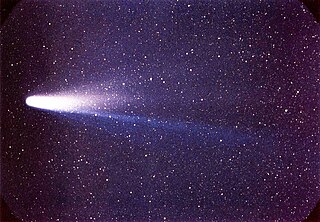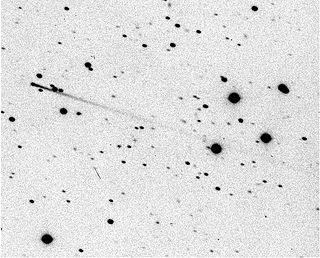Related Research Articles

A comet is an icy, small Solar System body that, when passing close to the Sun, warms and begins to release gases, a process called outgassing. This produces a visible atmosphere or coma, and sometimes also a tail. These phenomena are due to the effects of solar radiation and the solar wind acting upon the nucleus of the comet. Comet nuclei range from a few hundred meters to tens of kilometers across and are composed of loose collections of ice, dust, and small rocky particles. The coma may be up to 15 times Earth's diameter, while the tail may stretch beyond one astronomical unit. If sufficiently bright, a comet may be seen from Earth without the aid of a telescope and may subtend an arc of 30° across the sky. Comets have been observed and recorded since ancient times by many cultures.

Halley's Comet or Comet Halley, officially designated 1P/Halley, is a short-period comet visible from Earth every 75–76 years. Halley is the only known short-period comet that is regularly visible to the naked eye from Earth, and the only naked-eye comet that can appear twice in a human lifetime. Halley last appeared in the inner parts of the Solar System in 1986 and will next appear in mid-2061.

2060 Chiron is a small Solar System body in the outer Solar System, orbiting the Sun between Saturn and Uranus. Discovered in 1977 by Charles Kowal, it was the first-identified member of a new class of objects now known as centaurs—bodies orbiting between the asteroid belt and the Kuiper belt.

Comet Encke or Encke's Comet is a periodic comet that completes an orbit of the Sun once every 3.3 years. Encke was first recorded by Pierre Méchain on 17 January 1786, but it was not recognized as a periodic comet until 1819 when its orbit was computed by Johann Franz Encke. Like Halley's Comet, it is unusual in its being named after the calculator of its orbit rather than its discoverer. Like most comets, it has a very low albedo, reflecting only 4.6% of the light its nucleus receives, although comets generate a large coma and tail that can make them much more visible during their perihelion. The diameter of the nucleus of Encke's Comet is 4.8 km.

Comet Elst–Pizarro is a body that displays characteristics of both asteroids and comets, and is the prototype of main-belt comets. Its orbit keeps it within the asteroid belt, yet it displayed a dust tail like a comet while near perihelion in 1996, 2001, and 2007.
Damocloids are a class of minor planets such as 5335 Damocles and 1996 PW that have Halley-type or long-period highly eccentric orbits typical of periodic comets such as Halley's Comet, but without showing a cometary coma or tail. David Jewitt defines a damocloid as an object with a Jupiter Tisserand invariant (TJ) of 2 or less, while Akimasa Nakamura defines this group with the following orbital elements:
(65407) 2002 RP120, provisional designation 2002 RP120, is a trans-Neptunian object and damocloid from the outer Solar System. Its orbit is retrograde and comet-like, and has a high eccentricity. It was discovered on 4 September 2002 by astronomers with the LONEOS survey at Anderson Mesa Station, Arizona, in the United States. The unusual object measures approximately 14.6 kilometers (9.1 miles) in diameter and is likely elongated in shape. It is a slow rotator and potentially a tumbler as well. The object was probably ejected from the ecliptic by Neptune.

(55565) 2002 AW197 is a classical, non-resonant trans-Neptunian object from the Kuiper belt in the outermost region of the Solar System, also known as cubewano. With a diameter of at least 700 kilometers (430 miles), Brown considers it a highly likely dwarf planet candidate. Tancredi notes that photometric observations suggest that it is a spheroid with a high albedo and small albedo spots. However, its low albedo suggests it does not have planetary geology. It is approximately tied (to within measurement uncertainties) as the largest unnamed object in the Solar System and the largest planetoid without a moon. It was discovered at Palomar Observatory in 2002 and has a rotation period of 8.8 hours and a moderately red color.
118401 LINEAR, provisional designation 1999 RE70, is an asteroid and main-belt comet (176P/LINEAR) that was discovered by the Lincoln Near-Earth Asteroid Research (LINEAR) 1-metre telescopes in Socorro, New Mexico on September 7, 1999. (118401) LINEAR was discovered to be cometary on November 26, 2005, by Henry H. Hsieh and David C. Jewitt as part of the Hawaii Trails project using the Gemini North 8-m telescope on Mauna Kea and was confirmed by the University of Hawaii's 2.2-m (88-in) telescope on December 24–27, 2005, and Gemini on December 29, 2005. Observations using the Spitzer Space Telescope have resulted in an estimate of 4.0±0.4 km for the diameter of (118401) LINEAR.

7604 Kridsadaporn, provisional designation 1995 QY2, is an unusual, carbonaceous asteroid and Mars-crosser on a highly eccentric orbit from the outer regions of the asteroid belt, approximately 12 kilometers (7.5 miles) in diameter. It was discovered on 31 August 1995, by Australian astronomer Robert McNaught at Siding Spring Observatory near Coonabarabran, Australia. Due to its particular orbit, the C-type asteroid belongs to MPC's list of "other" unusual objects, and has been classified as an "asteroid in cometary orbit", or ACO. The asteroid was named in memory of Thai astronomer Kridsadaporn Ritsmitchai.

An extinct comet is a comet that has expelled most of its volatile ice and has little left to form a tail and coma. In a dormant comet, rather than being depleted, any remaining volatile components have been sealed beneath an inactive surface layer.
82P/Gehrels is a periodic comet that was discovered on October 27, 1975, by Tom Gehrels at the Palomar Mountain Observatory in California having a faint nuclear brightness of magnitude 17.
(343158) 2009 HC82 is an asteroid on a retrograde orbit, classified as near-Earth object of the Apollo group. The estimated 2-kilometer sized asteroid makes many close approaches to Earth, Venus, and Mars at a very high relative velocity. It may be an extinct comet or damocloid asteroid.

Comet Swift–Tuttle is a large periodic comet with a 1995 (osculating) orbital period of 133 years that is in a 1:11 orbital resonance with Jupiter. It fits the classical definition of a Halley-type comet with a period between 20 and 200 years. It was independently discovered by Lewis Swift on July 16, 1862 and by Horace Parnell Tuttle on July 19, 1862.
In observational astronomy, the observation arc of a solar system body is the time period between its earliest and latest observations, used for tracing the body's path. It is usually given in days or years. The term is mostly used in the discovery and tracking of asteroids and comets. Arc length has the greatest influence on the accuracy of an orbit. The number and spacing of intermediate observations has a lesser effect.
2000 DG8 is a dark centaur and damocloid on a retrograde and highly eccentric orbit from the outer region of the Solar System. It was first observed on 25 February 2000, by astronomers with the LINEAR program at the Lincoln Lab's ETS near Socorro, New Mexico, in the United States. It has not been observed since 2001. The unusual object measures approximately 16 kilometers (9.9 miles) in diameter.

C/2018 F4 (PANSTARRS) is a hyperbolic comet. It was discovered on 17 March 2018 when it was beyond the orbit of Jupiter, 6.4 AU (960 million km) from the Sun. It was quite far from the Sun and turned out to simply be an asteroidal object that was discovered before cometary activity was noticeable. As perihelion is inside the orbit of Jupiter, this object should become more active. In April 2018 it was determined to be a hyperbolic comet. Given that the incoming velocity was similar to that of an Oort cloud object, we can very confidently say that it is not of interstellar origin. C/2018 F4 fragmented around August 2020.
In planetary science, the term unusual minor planet, or unusual object, is used for a minor planet that possesses an unusual physical or orbital characteristic. For the Minor Planet Center (MPC), which operates under the auspices of the International Astronomical Union, any non-classical main-belt asteroid, which account for the vast majority of all minor planets, is an unusual minor planet. These include the near-Earth objects and Trojans as well as the distant minor planets such as centaurs and trans-Neptunian objects. In a narrower sense, the term is used for a group of bodies – including main-belt asteroids, Mars-crossers, centaurs and otherwise non-classifiable minor planets – that show a high orbital eccentricity, typically above 0.5 and/or a perihelion of less than 6 AU. Similarly, an unusual asteroid (UA) is an inner Solar System object with a high eccentricity and/or inclination but with a perihelion larger than 1.3 AU, which does exclude the near-Earth objects.
C/2014 OG392 is a comet discovered as a centaur on 28 July 2014 when it was 11.5 AU (1.72 billion km) from the Sun and had an apparent magnitude of 21. The comet was relatively easier to detect at this distance because the nucleus is estimated to be 20 km in diameter.
References
- 1 2 3 4 5 6 7 Abell, Paul A.; Fernández, Yanga R.; Pravec, Petr; French, Linda M.; Farnham, Tony L.; Gaffey, Michael J.; Hardersen, Paul S.; Kušnirák, Peter; Šarounová, Lenka; Sheppard, Scott S. (2003). "Physical Characteristics of Asteroid-like Comet Nucleus C/2001 OG108 (LONEOS)". 34th Annual Lunar and Planetary Science Conference. Bibcode:2003LPI....34.1253A.
- 1 2 French, Linda M. (2002). "Pre-Activity BVRI Colors of High-Inclination Comet C/2001 OG108 (LONEOS)". American Astronomical Society, DPS Meeting No. 34, #16.01. 34: 868. Bibcode:2002DPS....34.1601F.
- 1 2 3 4 5 6 7 8 "JPL Small-Body Database Browser: C/2001 OG108 (LONEOS)" (last observation: 2002-07-03; arc: 340 days). Jet Propulsion Laboratory . Retrieved 18 May 2011.
(Close approach uncertainty: (MaxDist of 0.434) – (MinDist of 0.408) * 149597870.7 = 3.9 million km) - 1 2 Horizons output. "Observer Table for Comet C/2001 OG108 (LONEOS)" (Soln.date: 2014-Jun-18). Retrieved 2 August 2020. (Observer Location:@sun Perihelion occurs when deldot flips from negative to positive)
- ↑ "JPL Small-Body Database Search Engine: comets and q < 1 (au) and period < 200 (years)". JPL Solar System Dynamics. Retrieved 24 July 2020.